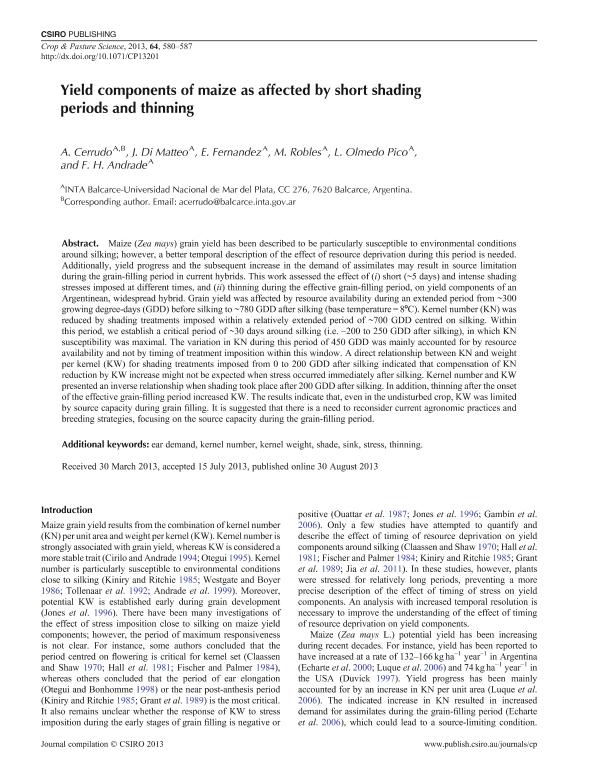Artículo
Yield components of maize as affected by short shading periods and thinning
Cerrudo, Anibal Alejandro ; Di Matteo, Javier Antonio
; Di Matteo, Javier Antonio ; Fernandez, Ezequiel; Robles, Mariana
; Fernandez, Ezequiel; Robles, Mariana ; Olmedo Pico, Lia; Andrade, Fernando Héctor
; Olmedo Pico, Lia; Andrade, Fernando Héctor
 ; Di Matteo, Javier Antonio
; Di Matteo, Javier Antonio ; Fernandez, Ezequiel; Robles, Mariana
; Fernandez, Ezequiel; Robles, Mariana ; Olmedo Pico, Lia; Andrade, Fernando Héctor
; Olmedo Pico, Lia; Andrade, Fernando Héctor
Fecha de publicación:
10/2013
Editorial:
Csiro Publishing
Revista:
Crop & Pasture Science
ISSN:
1836-5795
Idioma:
Inglés
Tipo de recurso:
Artículo publicado
Clasificación temática:
Resumen
Maize (Zea mays) grain yield has been described to be particularly susceptible to environmental conditions around silking; however, a better temporal description of the effect of resource deprivation during this period is needed. Additionally, yield progress and the subsequent increase in the demand of assimilates may result in source limitation during the grain-filling period in current hybrids. This work assessed the effect of (i) short (~5 days) and intense shading stresses imposed at different times, and (ii) thinning during the effective grain-filling period, on yield components of an Argentinean, widespread hybrid. Grain yield was affected by resource availability during an extended period from ~300 growing degree-days (GDD) before silking to ~780 GDD after silking (base temperature = 8°C). Kernel number (KN) was reduced by shading treatments imposed within a relatively extended period of ~700 GDD centred on silking. Within this period, we establish a critical period of ~30 days around silking (i.e. –200 to 250 GDD after silking), in which KN susceptibility was maximal. The variation in KN during this period of 450 GDD was mainly accounted for by resource availability and not by timing of treatment imposition within this window. A direct relationship between KN and weight per kernel (KW) for shading treatments imposed from 0 to 200 GDD after silking indicated that compensation of KN reduction by KW increase might not be expected when stress occurred immediately after silking. Kernel number and KW presented an inverse relationship when shading took place after 200 GDD after silking. In addition, thinning after the onset of the effective grain-filling period increased KW. The results indicate that, even in the undisturbed crop, KW was limited by source capacity during grain filling. It is suggested that there is a need to reconsider current agronomic practices and breeding strategies, focusing on the source capacity during the grain-filling period.
Palabras clave:
Ear Demand
,
Kernel Number
,
Kernel Weight
,
Shade
,
Sink
,
Stress
,
Thinning
Archivos asociados
Licencia
Identificadores
Colecciones
Articulos(CCT - MAR DEL PLATA)
Articulos de CTRO.CIENTIFICO TECNOL.CONICET - MAR DEL PLATA
Articulos de CTRO.CIENTIFICO TECNOL.CONICET - MAR DEL PLATA
Citación
Cerrudo, Anibal Alejandro; Di Matteo, Javier Antonio; Fernandez, Ezequiel; Robles, Mariana; Olmedo Pico, Lia; et al.; Yield components of maize as affected by short shading periods and thinning; Csiro Publishing; Crop & Pasture Science; 64; 6; 10-2013; 580-587
Compartir
Altmétricas



